The tree-dwelling rodents seem to have invaded backyards en masse, but no one knows for sure how many there are
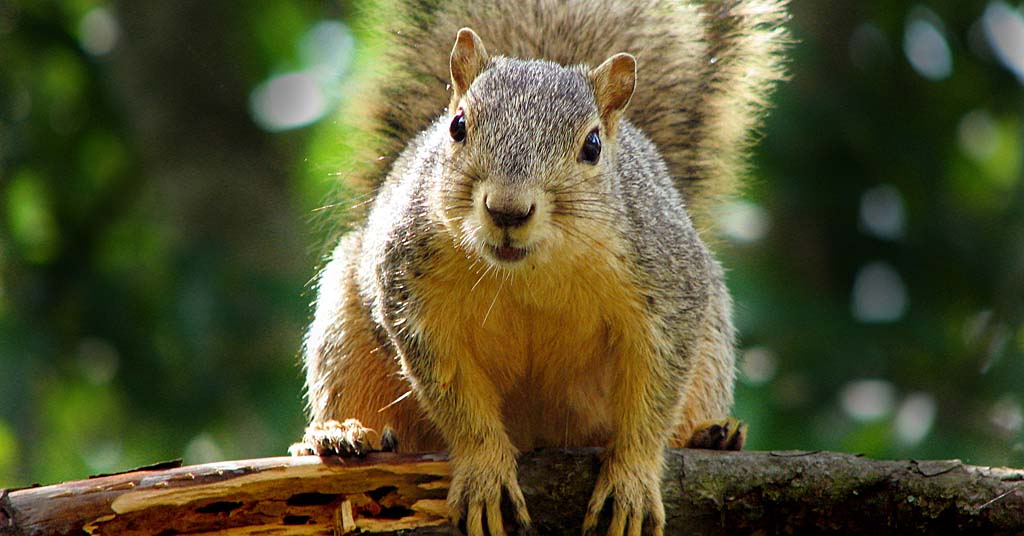
You looking at me? Portlanders have gotten used to unnerving stare-downs. Photo: Matt McGee/Flickr
By Chuck Thompson. August 22, 2024. I know I’m supposed to like them. Supposed to think they’re cute.
But over the past decade squirrels have nested in my attic, chewed holes in the roof of a wooden structure in my backyard and eaten through electrical wiring in my truck.
All of this has led to thousands of dollars in repairs.
What’s more they’ve become aggressive, brazen and hissy. They stare at me through windows, screech like wounded banshees at anything that comes into “their” territory, antagonize Sadie the Cat (be nice if she’d grow a backbone but that ship’s sailed) and stage sunrise track meets atop my roof.
And they keep coming.
Over the past couple of decades, squirrels have proliferated at an alarming rate in my densely populated Southeast Portland neighborhood.
Relatives and friends all over town—particularly on the east side of the Willamette River—report the same thing: squirrels in Portland are out of control.
They’ve coalesced into an army. They’re destructive. They’re getting worse.
Like many people I know, this is the stance on squirrels I’ve grown into over the past decade or so. (Interestingly, these are essentially the same problems our fellow citizens in rural areas have with cougars, wolves and elk—wildlife destroying property and causing financial distress.)
But is it accurate?
Though real and aggravating, my experiences with squirrels are anecdotal. So are those of friends and neighbors.
Have squirrels really become as big a problem in Portland as it seems to me they have?
Before my squirrel animus ascended to Rick and Morty levels, I decided to find out.
Who’s counting?
Since squirrels are rodents, and closely related to rats and mice, I assumed Multnomah County Vector Control was keeping an eye on the situation.
After all, this is the public office that “protects health and enhances livability through control of the rat and mosquito populations, and serves as a resource for addressing public health vector problems.”
The answer to my first question—“Is the squirrel population in Portland increasing?”—surprised me.
“The County’s Vector Control division does not manage squirrels, skunks, raccoons, coyotes or most wildlife,” a communications coordinator emailed me.
Huh. So no one at the county was keeping track of squirrels.
I sent an email blast to five local companies that advertise squirrel removal services. Got some squirrels you want disappeared? These are your guys.
I wanted to know if business was booming.
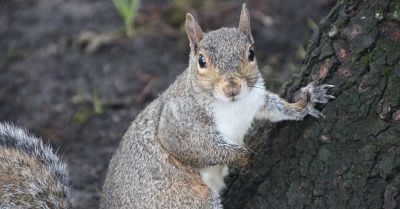
On the march: Eastern gray squirrel on the Portland State University campus. Photo: Corey Seeman/Flickr
Only one replied: Keith Chaloux, owner of Pest & Pollinator in Southeast Portland.
“Invasive squirrel management, like rodent control, is basically externalized onto the landowners that experience damage. They often hire Wildlife Control Operators (WCOs) like me, who are licensed through the Oregon Department of Fish and Wildlife,” wrote Chaloux. “I have been a WCO working with squirrels since about 2016, and it has always been a major pest by volume of calls.”
It turned out Chaloux had also been wondering about Portland’s squirrel population. He’d recently gone so far as to make a public records request to ODFW for squirrel data.
“But for the opposite reason—I suspected their numbers are declining, and was interested to learn that, yes, the number of Eastern gray squirrels captured by WCOs in Multnomah County actually has declined over the past few years,” he told me.
The stats Chaloux got from ODFW covering Eastern gray squirrel captures in the county reported by WCOs surprised me.
2023: 392
2022: 402
2021: 471
Those numbers seemed to disprove my suspicion about the squirrel uprising.
But given that they focus on just one species, and don’t involve reports from homeowners, they were of limited value.
“Unfortunately, I didn’t end up requesting a larger sample. Squirrel populations are dynamic, in part because of the concept of ‘mast years,’” Chaloux wrote, referring to years in which trees produce an unusually large number of fruits, seeds or nuts, creating a bumper crop that results in population booms among small mammals, like squirrels and mice.
Squirrel species
I began learning more about squirrels in the Pacific Northwest.
The most important information involved the types of squirrels in my backyard.
Oregon has four native tree squirrel species: Western gray, Douglas, American red and northern flying squirrels.
The Western gray squirrel is the largest of these four and the only one you’re likely to encounter in an urban setting. It has a creamy white belly and silvery gray fur, and ranges in length from 19 to 24 inches including the tail which is a bushy gray with black hairs.
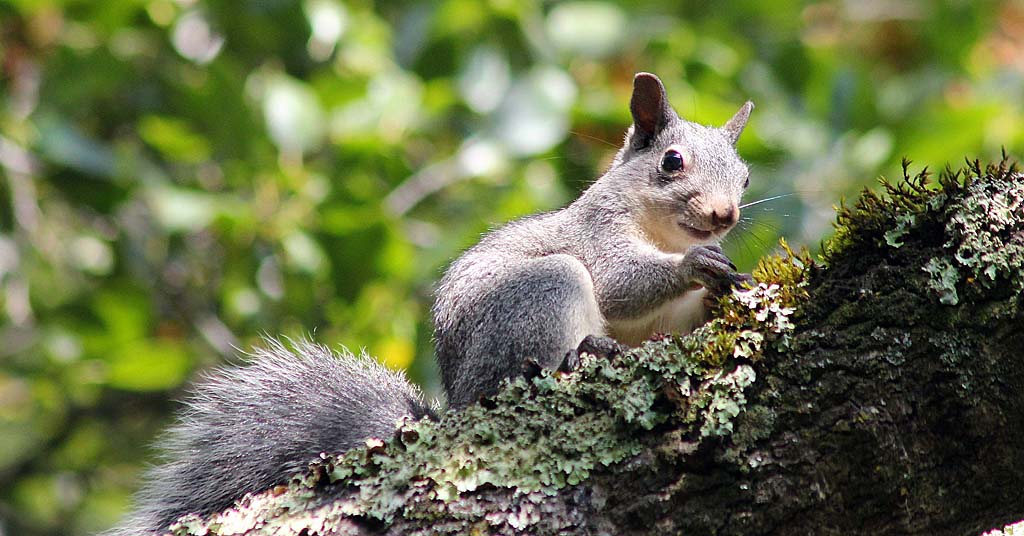
Pushed out: In Washington, the three remaining populations of the Western gray squirrels (pictured) are isolated and face a number of threats Photo: David Hofmann/Flickr
The big troublemakers among the squirrel set are Eastern gray squirrels and Eastern fox squirrels. Both are nonnative, invasive species.
A threat to native squirrels, these intruders aggressively compete for food and nesting resources, spread disease to native squirrels, reproduce at a high rate and possess a high tolerance of human activity, which allows them to expand their range. They also consume baby birds and bird eggs and thereby adversely affect native bird populations.
If you’re in a city in the Pacific Northwest and you’ve got a squirrel problem, it’s almost certain the Eastern gray squirrel or Eastern fox squirrel is your adversary.
Squirrel authority
Since ODFW licenses wildlife control operators like Chaloux, and since no one else seems to be paying attention to what the squirrels are getting up to, I fired off a message to state authorities.
This eventually led me to the man who probably knows more about squirrels in Portland than anyone.
Based in Clackamas, Dave Keiter is a district wildlife biologist with ODFW’s North Willamette Watershed District–Cascade Unit.
I peppered him with questions, starting with the biggie: Is the squirrel population in Multnomah County growing?
“It is difficult to know whether the squirrel population is expanding or not,” said Keiter. “Squirrel populations in certain areas of the city might be increasing as a result of favorable conditions—planting of mast species, feeding, reduction in free-roaming pet numbers—while decreasing in other places due to unfavorable conditions. … Squirrels, like many rodents, also undergo boom and bust population cycles in which populations can fluctuate over relatively short periods of time.”
Removal of invasive squirrels is likely to be a short-term solution due to rapid recolonization.
Keiter told me ODFW doesn’t have estimates of squirrel population sizes in Multnomah County, including for invasive species. The agency conducts limited monitoring of squirrels and what work it does is focused on conservation of native species.
“From staff observations and public data, very few Western gray squirrels are observed within the metro area and the vast majority of squirrels present are invasive Eastern gray squirrels or fox squirrels,” he said.
I asked about the numbers from Chaloux that suggest a decline in the squirrel population, but Keiter agreed this wasn’t a definitive measure.
“The relationship between the number of Eastern gray squirrels captured by WCOs and the actual number of squirrels on the landscape is unknown,” he said. “WCOs respond to reports of conflict. The amount of conflict can vary due to environmental conditions.”
Fighting squirrels
I griped about the vandalism to my backyard structure and chewed-up wires in my truck but detected little sympathy.
Had ODFW no worries whatsoever about Portland’s squirrel invasion?
Keiter more or less echoed an Oregon State University site I’d found about dealing with problem squirrels: “Learn to live with them.”
“Generally speaking we have relatively few concerns regarding squirrel populations in the Portland metro area,” said Keiter. “We strongly encourage residents not to feed wildlife, as feeding wildlife, including squirrels, often results in negative outcomes.”
As for remedies, on private land squirrels are managed as “predatory species” under Oregon Department of Agriculture rules, meaning they can be killed by landowners by appropriate and legal means without license or permitting requirements.
But sitting on the back porch plunking squirrels with a BB gun isn’t really me.

Temporary housing. Photo: Wildlifehelp.org
During my decade-long squirrel saga I’ve acquired some traps and confiscated a number of squirrels, but found this has no long-term impact.
“Removal of invasive squirrels is likely to be a short-term solution to squirrel issues due to relatively rapid recolonization and high birth rates,” said Keiter, confirming my suspicion that short of biological weapons or a robust falconing program squirrels are practically impossible to eliminate once they’ve moved into an area.
Anyway, you’re not allowed to just trap squirrels and dump them out in the woods.
“Relocation of wild animals without a permit is illegal in the state of Oregon,” said Keiter. “Relocation of invasive squirrel species from urban to rural areas poses one of the greatest potential threats to Oregon’s native squirrel species by facilitating their expansion into areas they otherwise might not colonize.”
ODFW has some tips for reducing conflicts with squirrels in urban areas:
- Never feed squirrels.
- Remove attractants, such as excessive brush, birdfeeders and pet food.
- Proactively seal off potential means wildlife can use to enter human buildings.
Fine, but for me that was Squirrel Duel 101.
I’ve been through all those steps and it hasn’t stopped the onslaught.
I know I’m supposed to like them.
Supposed to think they’re cute.
But they’re not making it easy. In fact, they’re making it tougher.
I’m not crazy, it’s not just me, right?






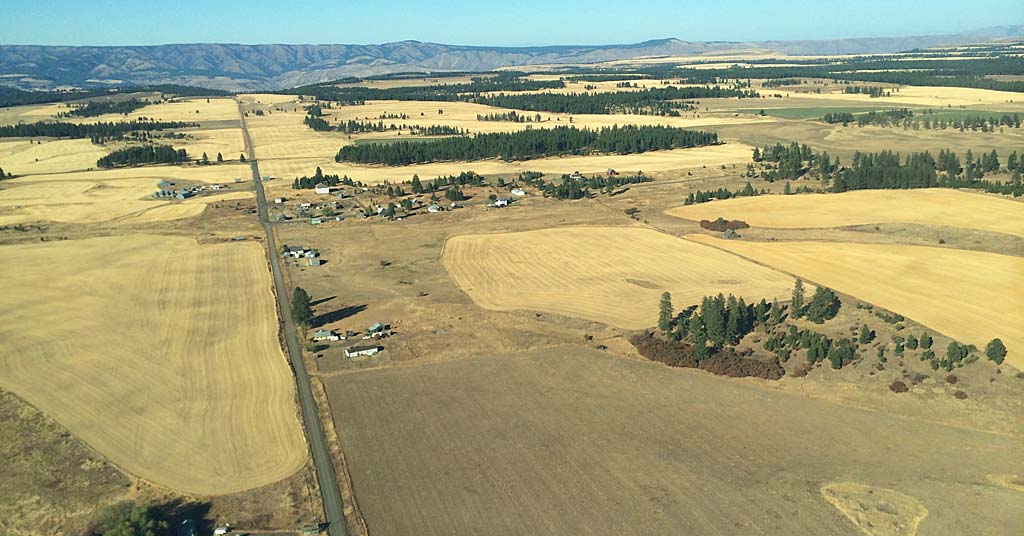
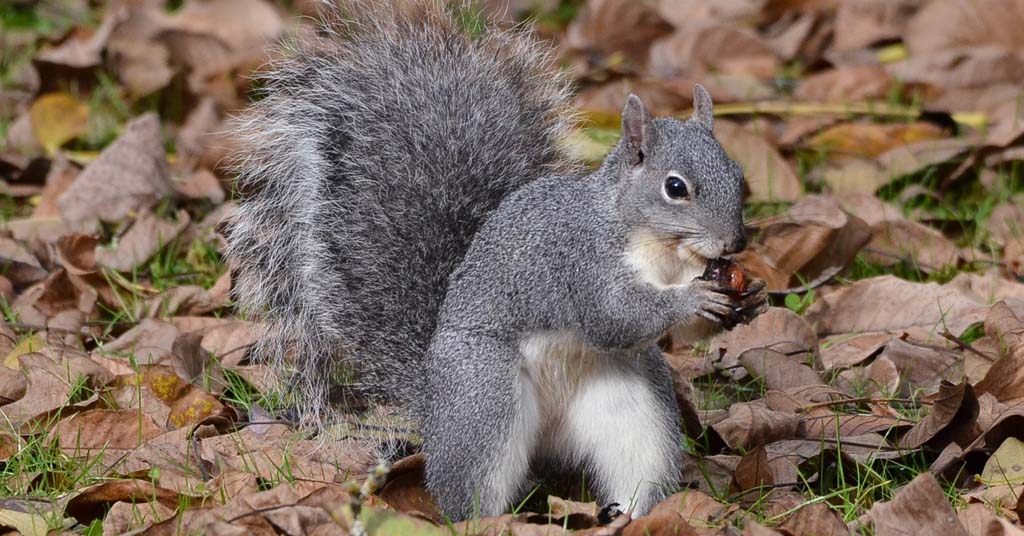



Squirrels have completely disappeared from our area. They must have all moved to Portland.
Lake Oswego
I very much doubt you will see a Western Gray Sq. in your yard unless you live somewhere with a lot of forest cover and a lot of oak trees. But if you would like to see one you have a half decent chance at Cooper Mt Nature Park in Beaverton
I feel your pain! We’ve borrowed dogs from friends to scare them from the area for a short period of time.
“The Western gray squirrel is the largest of these four and the only one you’re likely to encounter in an urban setting …”
Huh? You really don’t know what you’re saying. If you have squirrels in your yard in Portland, they are almost certainly eastern gray squirrels or eastern fox squirrels. You are highly unlikely to see to see native western gray squirrels right in the core of the city.
I remember western gray squirrels in my yard in Eugene back in the 80s, at the base of the south hills, but I don’t think those are there at all now.
Didn’t mean to reply to Leanne. Reply was to the article author.
Earlier this summer I asked an ODFW employee about trapping and relocating squirrels. He said, like this article, that it was illegal. When I asked about other options, he said perhaps, teach them to swim.
I have seen a definite decline in the squirrel population over the past years. Eight years ago there were 22 squirrels that came around now there are only 5 that come around.
Dont worry, at the rate we are destroying habitat, cutting down mature trees, they will eventually all be gone. I have been dealing with them for 25 years on the east side, there are fewer and their colorations have changed. They haven’t damaged vehicles or the house, but did get into an outbuilding and ripped up everything cardboard or cloth for bedding material, and if course I get upset at the moment, but realize they have little option and are opportunistic creatures. We destroy and they adapt, and we blame them. Just like the cougar and coyote.
Thank you for being understanding. The reason we in Oregon, California and other places on the West Coast have the Eastern Grey and Fox Squirrel is because humans brought them here. Why I do not know.
I doubt if they crossed the Great Plains/Desert States by themselves . I agree they were brought. Another example of humans screwing up nature. Had the species been left where they were and native to that area, we would have much less or no contact with the Greys and Foxes. I spent 40 years in California doing Wildlife Rehab and squirrels were one of my most numerous of animals.
Just please learn to live with them, they are here to stay, all of them. All creatures of nature including us.
I disagree. Eastern gray and fox squirrels are detrimental to native squirrels. If their numbers can be greatly reduced, they should be. And they cause quite significant property damage in urban areas in the PNW — not to mention they eat your tomatoes during dry periods and dig up your garden beds.
I’ve never seen a Western Gray Squirrel in Portland, but I do have native Douglas Squirrels in my SW Portland yard. The Douglas Squirrels are aggressive towards the two non-native species but greatly outnumbered.
If u want em outta your yard get a miniature schnauzer
Yeah but then you have a worse problem: a miniature schnauzer.
Could be worse — you could have a Jack Russel terrier. ?
I suspect Airedale terriers are the best at dispatching invasive squirrels. They will dispatch your neighbors cats also, though, if your neighbors are foolish enough to let their cats run around outside murdering native birds for kitty shts-n-giggles.